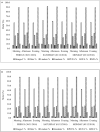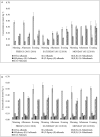"Real-World" Evaluation of Lipid Oxidation Products and Trace Metals in French Fries From Two Chain Fast-Food Restaurants
- PMID: 33614697
- PMCID: PMC7892784
- DOI: 10.3389/fnut.2021.620952
"Real-World" Evaluation of Lipid Oxidation Products and Trace Metals in French Fries From Two Chain Fast-Food Restaurants
Abstract
Differences in lipid oxidation products (LOPs) and trace metal concentrations of French fry samples found between two global chain fast-food restaurants in the UK were investigated using high-resolution proton nuclear magnetic resonance (1H NMR) and inductively coupled plasma-optical emission spectrometry (ICP-OES) analyses, respectively, of extracts derived therefrom. Over the course of 3 days and 3 different diurnal time periods, samples of French fries (FFs) were analyzed, and comparisons of two different oil extraction methods were undertaken for the two restaurants involved. The magnitude of concentrations of LOPs extracted from FFs is discussed. Significant differences between 6/7 aldehyde classifications, and aluminum, manganese, vanadium, lead, iron, copper and nickel levels between samples from the two restaurants are also reported. Redox-active transition and further trace metal concentrations inversely correlated with FF oil sample LOP contents; this suggested an antioxidant rather than a pro-oxidant role for them.
Keywords: French fries; aldehydes; fast-food restaurants; legislated metals; lipid oxidation products; proton nuclear magnetic resonance.
Copyright © 2021 Le Gresley, Ampem, De Mars, Grootveld and Naughton.
Conflict of interest statement
The authors declare that the research was conducted in the absence of any commercial or financial relationships that could be construed as a potential conflict of interest.
Figures










Similar articles
-
Comparative 1H NMR-Based Chemometric Evaluations of the Time-Dependent Generation of Aldehydic Lipid Oxidation Products in Culinary Oils Exposed to Laboratory-Simulated Shallow Frying Episodes: Differential Patterns Observed for Omega-3 Fatty Acid-Containing Soybean Oils.Foods. 2021 Oct 17;10(10):2481. doi: 10.3390/foods10102481. Foods. 2021. PMID: 34681530 Free PMC article.
-
Evidence-Based Challenges to the Continued Recommendation and Use of Peroxidatively-Susceptible Polyunsaturated Fatty Acid-Rich Culinary Oils for High-Temperature Frying Practises: Experimental Revelations Focused on Toxic Aldehydic Lipid Oxidation Products.Front Nutr. 2022 Jan 5;8:711640. doi: 10.3389/fnut.2021.711640. eCollection 2021. Front Nutr. 2022. PMID: 35071288 Free PMC article. Review.
-
The impact of partial oil substitution and trace metal ions on the evolution of peroxidation products in thermally stressed culinary oils.Food Chem. 2022 May 1;375:131823. doi: 10.1016/j.foodchem.2021.131823. Epub 2021 Dec 9. Food Chem. 2022. PMID: 34920305
-
Corn content of French fry oil from national chain vs. small business restaurants.Proc Natl Acad Sci U S A. 2010 Feb 2;107(5):2099-101. doi: 10.1073/pnas.0914437107. Epub 2010 Jan 19. Proc Natl Acad Sci U S A. 2010. PMID: 20133856 Free PMC article.
-
Metals, toxicity and oxidative stress.Curr Med Chem. 2005;12(10):1161-208. doi: 10.2174/0929867053764635. Curr Med Chem. 2005. PMID: 15892631 Review.
Cited by
-
Comparative 1H NMR-Based Chemometric Evaluations of the Time-Dependent Generation of Aldehydic Lipid Oxidation Products in Culinary Oils Exposed to Laboratory-Simulated Shallow Frying Episodes: Differential Patterns Observed for Omega-3 Fatty Acid-Containing Soybean Oils.Foods. 2021 Oct 17;10(10):2481. doi: 10.3390/foods10102481. Foods. 2021. PMID: 34681530 Free PMC article.
-
The Role of Polydimethylsiloxane in Suppressing the Evolution of Lipid Oxidation Products in Thermo-Oxidised Sunflower Oil: Influence of Stirring Processes.Front Nutr. 2021 Aug 10;8:721736. doi: 10.3389/fnut.2021.721736. eCollection 2021. Front Nutr. 2021. PMID: 34447780 Free PMC article.
-
Nuclear Magnetic Resonance Spectroscopic Analysis of the Evolution of Peroxidation Products Arising from Culinary Oils Exposed to Thermal Oxidation: An Investigation Employing 1H and 1H-1H COSY and TOCSY Techniques.Foods. 2022 Jun 24;11(13):1864. doi: 10.3390/foods11131864. Foods. 2022. PMID: 35804680 Free PMC article.
-
Evidence-Based Challenges to the Continued Recommendation and Use of Peroxidatively-Susceptible Polyunsaturated Fatty Acid-Rich Culinary Oils for High-Temperature Frying Practises: Experimental Revelations Focused on Toxic Aldehydic Lipid Oxidation Products.Front Nutr. 2022 Jan 5;8:711640. doi: 10.3389/fnut.2021.711640. eCollection 2021. Front Nutr. 2022. PMID: 35071288 Free PMC article. Review.
-
High-resolution 1H NMR analysis of continuous and discontinuous thermo-oxidative susceptibility of culinary oils during frying at 180 °C.J Food Drug Anal. 2023 Mar 15;31(1):95-115. doi: 10.38212/2224-6614.3439. J Food Drug Anal. 2023. PMID: 37224552 Free PMC article.
References
-
- Grootveld M, Silwood C, Addis P, Claxson A, Serra BB, Viana M. Health effects of oxidised heated oils. Foodservice Res Internat. (2001) 13:39–53. 10.1111/j.1745-4506.2001.tb00028.x - DOI
LinkOut - more resources
Full Text Sources
Other Literature Sources

